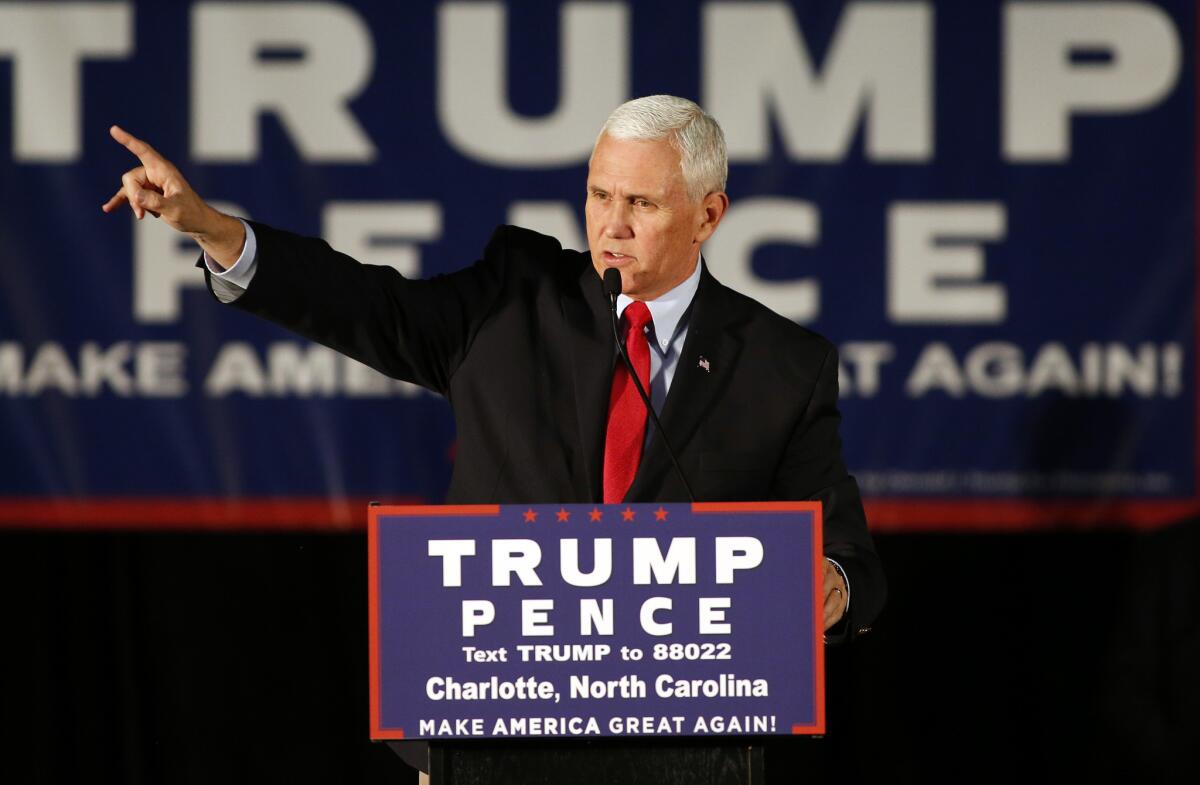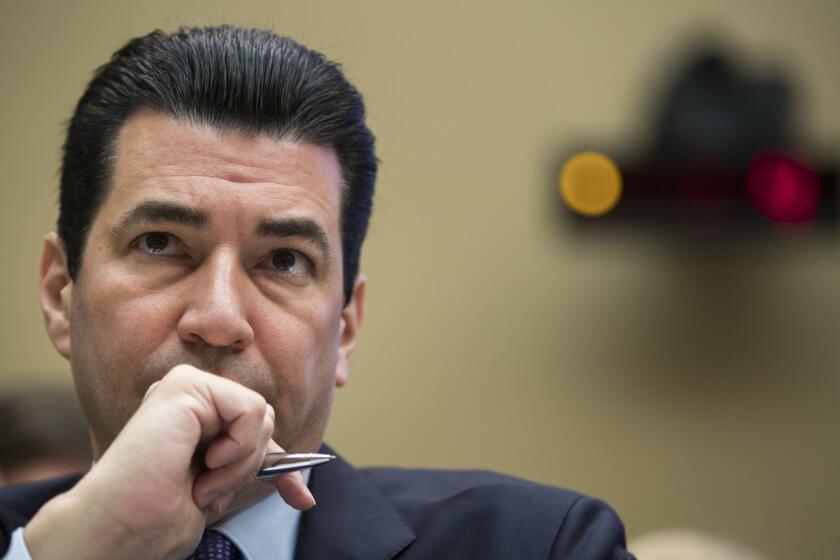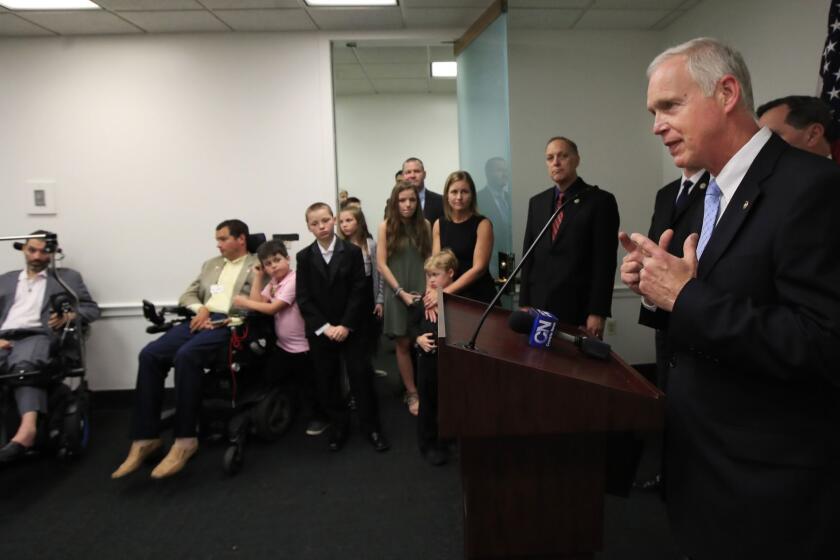Column: The Koch-backed right-to-try law has been a bust — but still threatens our health

The federal right-to-try law, signed by President Trump in May 2018 as a sop to right-wing interests, including the Koch brothers network, always was a cruel sham perpetrated on sufferers of intractably fatal diseases.
As we’ve reported, the law was promoted as a compassionate path to experimental treatments for those patients — but in fact was a cynical ploy aimed at emasculating the Food and Drug Administration in a way that would undermine public health and harm all patients.
Now that a year has passed since the law’s enactment, the assessments of how it has functioned are beginning to flow in. As NYU bioethicist Arthur Caplan observed to Ed Silverman’s Pharmalot blog, “the right to try remains a bust.”
This law intends to diminish the FDA’s power over people’s lives, not increase it.
— Sen. Ron Johnson (R-Wis.) about the right-to-try law
His judgment is seconded by the veteran pseudoscience debunker David Gorski, who writes: “Right-to-try has been a spectacular failure thus far at getting terminally ill patients access to experimental drugs.”
That should come as no surprise, Gorski adds, because “right-to-try was never about helping terminally ill patients. ... It was always about ideology more than anything else. It was always about weakening the FDA’s ability to regulate drug approval.”
Indeed, the measure’s chief supporter in the Senate, Ron Johnson (R-Wis.), let the cat out of the bag the very day after Trump signed the bill. “This law intends to diminish the FDA’s power over people’s lives, not increase it,” Johnson told then-FDA Commissioner Scott Gottlieb.
Never mind that the “FDA’s power over people’s lives” involves its working to ensure that drugs hawked to the American public are safe and effective.
Handing the Koch brothers and their fellow right-wing ideologues a big victory, the House on Tuesday passed a right-to-try bill that will harm patients and emasculate the Food and Drug Administration.
Drug manufacturers, who were expected to be reassured by the law that they could provide experimental drugs to patients without facing regulatory enforcement, haven’t been enthusiastic users of the privilege. Of 19 manufacturers who told the Government Accountability Office that they would entertain requests from patients for access to experimental treatments, 13 said they would want a regulatory agency to review the requests before agreeing, including six that specified a review by the FDA.
N one of this has stopped Trump from making up claims about the law. “A lot of people are being saved,” Trump said at a White House event on Sept. 11, offering a fact-free assessment while Health and Human Services Secretary Alex Azar and Acting FDA Commissioner Ned Sharpless sat silently by nearby, according to S&P Global Intelligence.
This may have been Trump’s way of validating the claim he made upon the bill-signing when he said the measure would save “hundreds of thousands” lives. That claim was pure fantasy, then, and it is now.
Right-to-try advocates claim that two patients have benefited from the federal law thus far. But the claim doesn’t hold water. In one case involving an anonymous patient suffering from glioblastoma, the aggressive cancer that felled both John McCain and Ted Kennedy, it turns out that both the FDA and the institutional review board of UC Irvine were involved in oversight. According to Caplan and two colleagues who reviewed the case in January, providing the patient with the drug, Gliovec, took longer than it would have under existing FDA procedures.
“This case is not a strong argument either for the need for a right-to-try policy or even that a right-to-try pathway was utilized,” they wrote.
A second case involves Matthew Bellina, a victim of amyotrophic lateral sclerosis or Lou Gehrig’s disease, who was treated with a drug called NurOwn by manufacturer Brainstorm under the right-to-try law. But the drug hasn’t been shown to be significantly more effective than a placebo, and Brainstorm says it’s not giving the drug to any more patients under right-to-try but would continue testing the drug via an FDA-approved Phase 3 trial, which it called “the best and most credible pathway” to establishing the safety and efficacy of NurOwn for ALS.
Anyone with a smidgen of knowledge about healthcare understood that the right-to-try legislation signed by President Trump on Wednesday was a scam, perpetrated by the Koch brothers and their henchmen.
To Gorski, the case suggests that “by treating Bellina, Brainstorm was currying favor with President Trump and the powerful legislators who got the law passed.”
These cases underscore that the right-to-try law was an unnecessary, even dangerous alternative to the FDA’s existing expanded access program to provide experimental drugs to patients with otherwise incurable terminal diseases.
The model law had been cooked up by a right-wing outfit called the Goldwater Institute, which had ties to the Koch brothers network. The institute managed to persuade a number of states to enact right-to-try laws, but the grail was a federal version. The campaign on Capitol Hill was spearheaded by Vice President Mike Pence and assisted by other Koch groups such as Freedom Partners and Americans for Prosperity.
Their pitch was that patients were ill-served by a cumbersome bureaucracy at the FDA, but that was simply a lie. The truth was that the FDA’s expanded access program approved more than 99% of applications from patients, delivering a decision on average between eight and 26 days. As Caplan and his co-authors wrote: “In emergency situations, the FDA routinely approves [expanded access] requests within 24 hours.” As I documented last year, the Koch agents weren’t above lying about criticisms of their proposal, including mine.
You can always tell that defenders of a dangerous and irresponsible law have nothing to offer when they resort to flagrant misrepresentation to make their case.
What the right-to-try advocates really were attacking was FDA regulation. The right-to-try bill was designed to cut the FDA out of the approval process for drugs administered to terminal patients. It allows terminal patients to obtain experimental drugs directly from their manufacturers, as long as the drugs have passed Phase 1 testing and are in Phase 2. That’s a low bar, since the goal of Phase 1 is simply to show that a drug isn’t so toxic it can’t be used.
Doctors, pharmacists and manufacturers involved in providing the drug are protected from liability. Crucially, the FDA can’t use the outcomes of right-to-try uses to determine a drug’s eventual suitability — in other words, if a drug sickens or kills a patient or has no effect in right-to-try treatments, those facts can’t be used in the FDA-approval process. “Basically, critical protections provided by the FDA to patients in clinical trials are not in effect in right-to-try,” Gorski observes. Insurers won’t cover the treatments, so the patients can face bills in the six figures.
The greater threat of right-to-try is to the broad American public. As Holly Fernandez Lynch and Steven Joffe of the University of Pennsylvania warned last year in the New England Journal of Medicine, granting patients with life-threatening illnesses a “right to try” experimental drugs without FDA oversight is a slippery slope. “This logic could ultimately extend to patients with serious chronic illnesses and … to all patients who find their approved treatment options unsatisfactory.”
The consequences could reach all patients who depend on the FDA to determine the safety and efficacy of drugs. “Are we prepared to abandon the FDA’s gatekeeping role in favor of unfettered patient autonomy and market forces,” Fernandez Lynch and Joffe asked, “risking precisely the problems that prompted Congress to grant the FDA its present authority?”
As it has turned out, most responsible drug companies don’t relish the latitude granted them by the right-to-try law. They prefer the oversight afforded by the FDA process, which requires a physician to be closely involved in the application for access and keeps the FDA in the loop. Only companies hoping to profiteer from the desperation of terminal patients and their families tend to show interest in right-to-try — them, and right-wing ideologues who believe that a government regulator’s efforts to protect consumers from useless or dangerous drugs is an unacceptable infringement on individual liberty.
On the plus side, most drug companies seem still to desire to play it straight. On the negative side, right-to-try was the first step in eroding the authority of one of the nation’s most important agencies safeguarding public health. Members of the public — those who suffer from terminal diseases and those who just want safe and effective drugs for any condition — are the losers.
More to Read
Inside the business of entertainment
The Wide Shot brings you news, analysis and insights on everything from streaming wars to production — and what it all means for the future.
You may occasionally receive promotional content from the Los Angeles Times.














